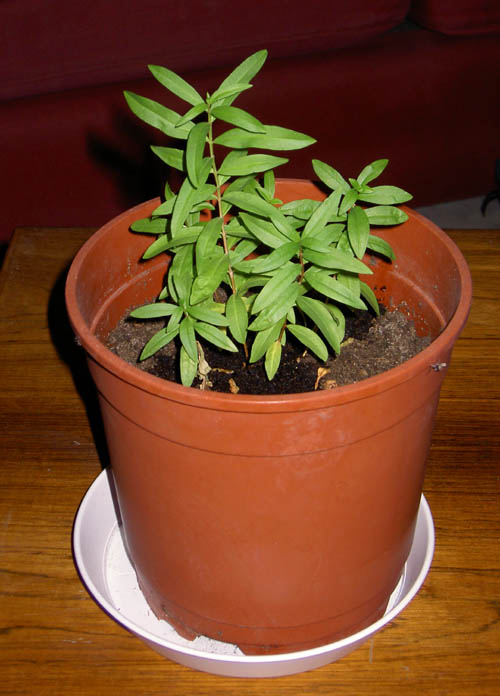- Sinicuichi
:"Heimia redirects here. For the
brachiopod genus, see "Heimia (brachiopod) .Taxobox
name = Sinicuichi

image_width = 240px
regnum =Plant ae
divisio = Magnoliophyta
classis = Magnoliopsida
ordo =Myrtales
familia =Lythraceae
genus = Heimia
subdivision_ranks = Species
subdivision = "Heimia myrtifolia " "Heimia salicifolia "Sinicuichi ("Heimia"), also known as sun opener or shrubby yellowcrest, is a genus of two or three species of
shrub s in the familyLythraceae , native tothe Americas , from northernArgentina north to the southernmostUnited States (southernTexas ). The leaves are 2-5 cm long and 1 cm broad, entire, and variably arranged alternate, opposite or whorled on the stems.pecies
*"
Heimia myrtifolia " is a shrub growing to 1 m tall. The yellow flowers are 5 petaled and 1 cm in diameter. The leaves are approximately 5 mm wide by 2-3 cm long.
*"Heimia salicifolia" is a shrub growing to 3 m tall. The yellow flowers are 5 petaled and 2-3 cm in diameter. The leaves are approximately 1 cm wide and 3-5 cm long.Identified Alkaloids
In a study done on Heimia salicifolia by the National Center for Natural Products Research, the following alkaloids were identified. Alkaloids from Heimia salicifolia. [http://www.ncbi.nlm.nih.gov/pubmed/18374955 Pubmed article] ]
*
9beta-hydroxyvertine
*(2S,4S,10R)-4-(3-hydroxy-4-methoxyphenyl)-quinolizidin-2-acetate
*lythrine
*dehydrodecodine
*lythridine
*vertine
*heimidine
*lyfoline
*epi-lyfoline Secondary metabolites
Both "Heimia" species contain the following
secondary metabolites :*
Cryogenine , psychoactive
*Sinicuichine
*Heimidine
*Lyfoline
*Nesodine
*Abresoline
*Anelisine
*Dehydrodecadine
*Sinine History
"Heimia myrtifolia" and "Heimia salicifolia" are often erroneously reported to be psychoactive. This controversial attribution of psychoactive effects appears to be traceable back to a publication by J. B. Calderon in 1896 who wrote that it was said to possess a "curious and unique physiological action ... people drinking either a decoction or the juice of the plant have a pleasant drunkenness ... all objects appear yellow and the sounds of bells, human voices or any other reach their ears as if coming from a long distance."
Calderon actually tested the plant and did not experience any noticeable effects. Through a series of exaggerating and dramatizing citations, especially by
Victor A. Reko in the first half of the last century, the plant became known as ahallucinogen despite that psychoactive properties of the plant have never been demonstrated. The mildly psychoactive effects described in the original publication have therefore been attributed to unknown other contents of the brew or, simply, to itsalcohol content Heimia salicifolia: A phytochemical and phytopharmacologic review. M. H. Malone , A. Rother, "J. Ethnopharmacol." 42(3):135-159 (1994) PMID 7934084 [http://dx.doi.org/10.1016/0378-8741(94)90080-9 doi 10.1016/0378-8741(94)90080-9] [http://erowid.org/references/refs_view.php?A=ShowDoc1&ID=6470 Erowid references] ]Cultivation
The species make attractive
ornamental plant s, flowering in late summer. Although only growing as ashrub in subtropical climates, it can also be grown as a herbaceous perennial in colder areas where the above-ground growth is killed by winter cold.The plants produce very many tiny seeds which are easily cultivated. The seeds should be sown thinly across the top of fine, packed soil. Both species perfer well-drained soil with a good supply of water. The seedlings should be watered by a fine mist or with bottom watering to avoid washing them off to the side of the pot. They should be kept out of intense sunlight until they form the first real leaves. It may be necessary to spread the seedlings out in their initial pots to avoid over-crowding. The seedlings should be moved to at least an inch apart once they are large enough to handle. Be aware that small seedlings of this species often have relatively large root structures. A plant less than a quarter-inch tall may have roots up to two inches deep.
References
Wikimedia Foundation. 2010.
